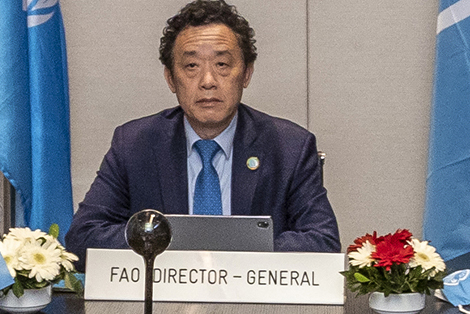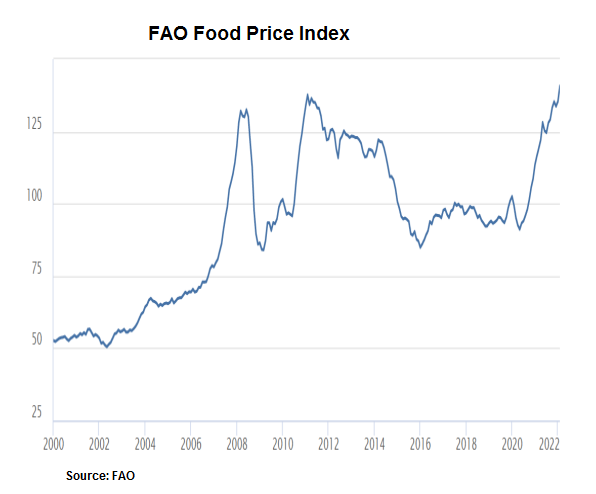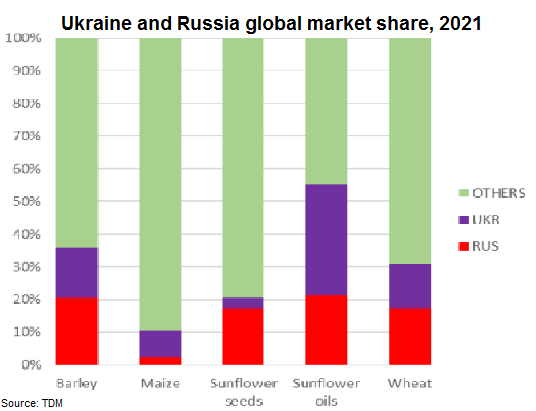
- Food supplies for millions of people around the world may be impacted by the war between two giant wheat and maize producers
- The Food and Agriculture Organization says the Ukraine crisis is a challenge to global food security, especially for low-income countries and vulnerable population groups
- With Ukraine’s ports shut or blockaded, shipping food from other sources are likely to increase operational costs of importers, says FAO head
Russia’s invasion of Ukraine, which has taken a heavy toll on the country and its people, could seriously impact the food security of millions of people around the world, the United Nations Food and Agriculture Organization warned at the weekend.
FAO Director-General Qu Dongyu told the extraordinary meeting in Rome of the Group of 7 agricultural ministers on March 11 that the Ukrainian crisis is a challenge to food security for many countries, especially those with low income, and for vulnerable population groups that depend on food imports.
A day earlier, at FAO’s 36th Asia Pacific Regional Conference in Dhaka, Bangladesh, Qusaid Asia-Pacific agrifood systems had been particularly vulnerable to shocks from the pandemic and other challenges, quickening the adoption of digital technologies.
Qu warned ministers from Canada, France, Germany, Italy, Japan, the United Kingdom and the United States that sourcing food from different origins as Ukraine’s ports are shut or blockaded due to the war, will increase shipping and other operational costs for many importers.
Particularly vulnerable are countries that rely on the Black Sea supplies due to the region’s proximity, the FAO head said.
“Already prior to the crisis, international food prices reached an all-time high. This was mostly due to market conditions, but also high prices of energy, fertilizers and also all other agricultural services,” Qu said.
He said that last month, the FAO Food Price Index rose 21% year on year to a historical record, 2.2% higher than its previous peak in February 2011.

Qu said Russia and Ukraine are prominent players in global trade of food and agricultural products. In 2021, Russia and Ukraine’s wheat exports accounted for about 30% of the global market while their combined sunflower oil exports made up 55%.

“Wheat is a staple food for over 35% of the world’s population, and the lack of a substitute is likely to compound the pressure on wheat prices,” Qu warned.
The two countries are prominent in in the world trade arena for the maize, barley and rapeseed oil exports, Qu said. He added that Russia was the top global supplier of nitrogen fertilizers in 2020, the No.2 supplier of potassium and No.3 exporter of phosphorous fertilizer.
In terms of trade networks, both countries are key suppliers of wheat to many countries, with nearly 50 countries depending on them for at least 30% of their wheat imports. Of these countries, 26 source more than 50% of their wheat imports from Russia and Ukraine, he said.
For fertilizers, 25 countries rely on Russia for 30% or more of their nitrogen, potassium and phosphorous fertilizers.
At the FAO regional meeting Dhaka on March 11 Qusaidat said the systems governing how food is produced, distributed and consumed had been impacted by the pandemic and other challenges, with the Asia Pacific region “particularly vulnerable to these shocks.”
“This has forced us to reconsider our priorities and approaches, and has highlighted the importance of more sustainable and resilient societies,” Qu said at the “Innovation, Science and Digitalization” event at the conference.
He said digital technologies are having a profound impact on Asia-Pacific economies and societies and their transforming agrifood markets has been accelerated by COVID-19.
He said about 40% of the population of the Asia Pacific cannot afford food prices and in some areas the fight to achieve the UN’s sustainable development goals of defeating poverty and hunger had been set back.
On the other hand, Qu said there has been increasing movement towards innovation and digitalization along the entire agrifood value chain. In retail grocery and food shopping, four out of every five online food and grocery purchases take place in the region.
In the small island developing states of the Pacific, entrepreneurs are coming up with ideas such as smartphone apps that help producers and consumers make informed, nutritious choices, Qu said. This leveraging of data is helping improve the supply chain of agricultural commodities to markets and mapping areas vulnerable to extreme weather events.
Qu said digital innovation in agriculture holds the key to unlocking employment opportunities, bridging the rural divide and empowering youth and women to access information, technology and markets.








